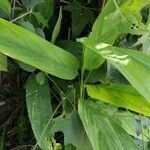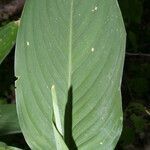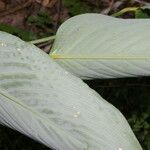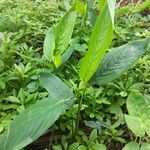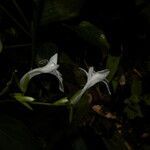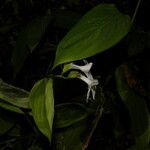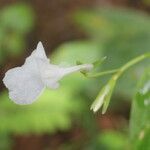Plants erect, 0.3--1.3 m. Rhizomes tuberous, thickened. Stem often branched above. Leaves: basal 4--8, cauline 1--8; sheath auriculate, 4.5--31 cm, margins and apex densely pilose to nearly glabrous; petiole often absent in cauline leaves, 3.5--20 cm; pulvinus 0.2--1.8 cm, adaxially tomentose; blade ovate, 3.5--35 ´ 3--11 cm, basal leaves largest, abaxially glabrous to minutely pilose, adaxially sparsely minutely pilose. Inflorescences: bracts 1--2(--3), 2.4--6 cm; common pedicel of flower pair 2.3--5.5 cm. Flowers: sepals 10--17 mm; corolla white, corolla tube curved, 12--14 mm; staminodes white; ovary tan, densely pubescent, rarely glabrous or nearly glabrous. Fruits green or tinged red-brown, 8 ´ 4--5 mm. 2n = 18, 2n = 48.
Rather weak, diffusely branching herbs 4-8 dm. tall, essentially glabrous throughout; leaves both basal and cauline, ovate to ovate-lanceolate, rather gradually acute to acuminate, base broadly obtuse, 10-20 cm. long, 3-8 cm. broad; petiole 1.0-1.5 cm. long, wholly callous; sheaths very narrow, 5-10 cm. long; inflorescence diffusely branching, the rachis rather distantly flexuous, several-to many-flowered; bracts caducous, oblong, obviously leafless sheaths, 2-4 cm. long; pedicels 0.5-1.5 cm. long; sepals ovate-lanceolate, 1.0-1.5 cm. long, per-sistent and accrescent in fruit; perianth (including the staminodia) about 2 cm. long, white; fruits nut-like, ellipsoid, about 1 cm. long.
A perennial plant up to 2 m high with large fleshy underground rhizomes. The stem is erect. There are 4-8 leaves near the base. There are 1-8 leaves on the stem. It has large leaves on long stalks near the base. These stalks can be 3.5-20 cm long. The leaf blade is 12 cm long and the leaf stalk clasps the stem. Flowers are small and white. There can be several on each leafy shoot. They occur on the ends of branches. There are 1-2 bracts under each 2-3 flowers. The rhizomes can be 20 cm long and about 3 cm across. They are covered with fleshy scales. The fruit are capsules which are green and tinged red-brown. They are oval and 7-8 mm long by 4-5 mm wide. The seeds are brown.
